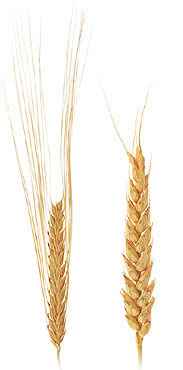 There’s a nearly endless debate among brewers about the merits of two-row barley versus six-row barley. Some homebrewers have a preference for one over the other, but in fact, neither is “better” than the other. Both six-row and two-row malt have their place in craft and home brewing. This post will explain the difference between six-row and two-row barley and will help you make the best decision about which to use.
There’s a nearly endless debate among brewers about the merits of two-row barley versus six-row barley. Some homebrewers have a preference for one over the other, but in fact, neither is “better” than the other. Both six-row and two-row malt have their place in craft and home brewing. This post will explain the difference between six-row and two-row barley and will help you make the best decision about which to use.
It’s important to keep in mind that as an agricultural crop, barley varies from season to season, from crop to crop, and from field to field. However, generally speaking…
Six-row barley is:
- arranged in six rows around the stalk
- smaller in kernel size than two-row barley
- higher in protein content
- higher in husk content
2 Row Barely is:
- arranged in two rows, on opposite sides of the stalk
- larger in kernel size
- lower in protein content
- lower in husk content
In the early days of colonization, six-row barley grew more readily in North America than two-row, whereas in Europe, six-row was primarily used for feed. Therefore it is more common to find six-row barley in American-style ales and lagers than it is to find it in traditional European styles. That said, modern advancements in agriculture have allowed both two-row and six-row barley to be grown in North America.
So, which should you use in your beer?
Because of the larger kernel, two-row barley provides more extract potential per pound than six-row barley: 37 points per gallon vs. 35. This often makes it more cost effective for larger breweries to use two-row, but for the average homebrewer the cost savings is negligible.
Though two-row barley offers more extract potential, six-row offers more diastatic power than two-row malt. This makes six-row barley ideal for brewing with high quantities of adjuncts and/or specialty grains. Because grains like rice and corn don’t contain the necessary enzymes for conversion, six-row is ideal for brewing adjunct lagers.
Here is a summary of the difference between two row and six row barley:
- Both two-row and six-row malt make for a great “go-to” base grain for many styles across the board, though you may get more extract per pound using two-row malt.
- The higher protein content in six-row malt may increase a beer’s body and head potential, but brewers should take care to get a good hot break to avoid haze formation later in the process.
- Six-row can be helpful when brewing a partial mash recipe. The extra diastatic power can help conversion of the mini-mash if there is a high proportion of adjunct or specialty grains.
- Six-row barley is most commonly used for American beers. Consider six-row if brewing traditional American styles such as American pilsner, American wheat beer, and American cream ale.
- Due to six-row’s smaller kernel size, grain mills may need to be set to a slightly smaller grind.
If you’re open to experimentation, try this: Brew two identical batches of beer, one using two-row malt and the other using six-row malt. Keep the hop schedules, yeast selection, and fermentation schedules the same. Can you tell a difference between two row and six row barley? What are the characteristics of each beer? Which do you prefer?
————————————————————————————————————-
David Ackley is a beer writer, brewer, and self-described “craft beer crusader.” He holds a General Certificate in Brewing from the Institute of Brewing and Distilling and is founder and editor of the Local Beer Blog.

Can you tell the two seed variety of lacey and tradition apart. Can you tell two row seed varieties meredeth and pinnacle apart
Bill, I am sorry we just do not know the difference.